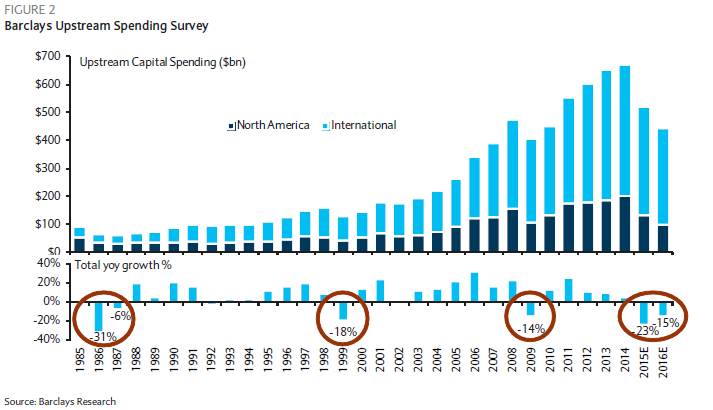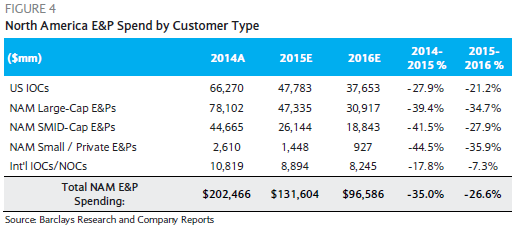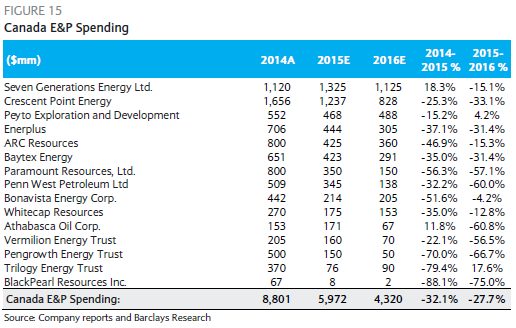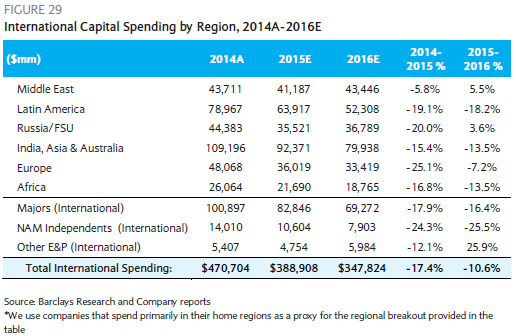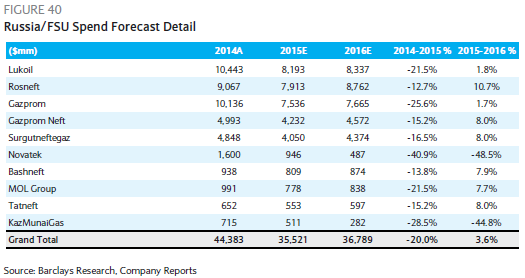2016 global E&P spending expected to decline 15%-20% in 2016: Barclay’s
“That’s what Friends are For” was the Billboard Top 100 song the last time this happened. Exploration and production spending is expected to decline by 15% this year. That’s on top of a 23% decline last year, making 2016 the eighth decline in global spending in the last 31 years, and only the second consecutive two-year reduction in spending seen in the period.
According to Barclay’s E&P Spending Outlook, which has been conducted annually over the last three decades, the last time a double-dip was seen was 1986-1987 when E&P spending fell 31% and 6%, respectively.
WTI was above $40 per barrel when the survey was initially conducted, however, meaning that expectations for E&P spending could go lower given that WTI is currently hovering near $30 per barrel. Barclay’s expects spending cuts to push closer to 20% if oil prices hold at $40 per barrel.
North American E&Ps are expected to cut into their budgets even further, with expectations of a 27% decline in spending for 2016. So far, only about 15% of companies have officially announced budgets, and those still to be released are expected to be more strongly affected by the price of oil than last year’s budgets because of fewer hedges.
International companies are expected to fare better than those in North America, with the survey predicting an 11% decline in 2016, following a 17% reduction in spending last year. U.S. IOCs are expected to lower spending by 16%, European IOCs by 9% and national oil companies (NOCs) are expected to cut spending by 9% this year.
Capital discipline: easier said than done
Companies have been targeting operating inside of cash flow since oil prices began their rapid decline in November 2014, and many are hoping to do the same again this year, but many have struggled to actually meet that goal.
Oil prices have been a moving target over the past 14 months, and most companies didn’t bring down spending fast enough last year in order to keep spending inside of cash flow. Large-cap E&Ps in North America spent 135% of cash flow in 2015, while mid-cap spent 188% of cash flow, according to Barclays.
65% of respondents last year said they planned to spend inside of cash flow, but only 50% were successful, with 36% of companies spending 120% compared to less than 20% of companies that said they planned to spend that much, reports Barclays.
If WTI and Brent remain in the $34/$35 per barrel range, the North American budgets that have yet to be announced could be drastically lower as companies aim to stay inside of cash flow. “North American upstream spending could be down 40-50% if current futures prices hold at ~$34/$35 per barrel,” said the Barclays report (emphasis Barclays’).
Canada expected to follow the larger North American trend
Canadian E&Ps are expected to reduce their spending by 27.7% this year, closely following the 26.6% decline Barclays sees for North America. Many E&Ps do not break out their Canadian spending versus their U.S. spending, but the firm estimates that Canada represents about 15% of total North America spending.
E&P companies are stretching their capex dollar further
Companies have hi-graded operations and pushed service costs lower in order to keep production commercial in the last year. The survey indicated that 70% of E&Ps have seen well costs fall more than 20%, while one-third said well costs were down 30%.
International spending expected to decline 11% with exceptions
Overall spending by IOCs is expected to fall in 2016 by around 11%, with the largest cuts expected in Latin America where spending is “in free fall.” India, Asia and Australia are expected to cut spending by 13.5%, while Europe and Africa are expected to spend 7.2% and 13.5% less, respectively.
Interestingly, there were exceptions to spending cuts in the two international regions covered in the report. The Middle East, as well as Russia and the Former Soviet Union, are both expected to increase spending on E&P operations in 2016.
A large portion of the expected spending increase in Saudi Arabia is expected to come from Saudi Aramco, the world’s largest national oil company. Saudi Arabia said at the end of December that it plans to cut back spending by about 14%, but its state-owned oil company is still expected to increase spending by roughly 5% as the company continues to produce at as high a rate as possible, according to sources inside of Aramco.
The high production will keep oil well below the actual breakeven levels of many of OPEC’s members, but most have large sovereign funds to use as a financial cushion as oil prices remain low. Strong financial reserves are not universal among OPEC members, however, and those who are not as fiscally stable will continue to damage further as oil prices remain low.
“With oil revenue as the dominant economic driver for each of these countries, pain will not be distributed evenly, creating a distinct line between the ‘haves’ and the ‘have nots,’” said the report.
One bright spot created by Saudi Aramco’s higher spending is a healthy backlog of construction work for international firms, Barclays commented during a conference call that accompanied the release of the survey results.
Russia expected to increase spending even as the finance minister proposes 10% cuts nearly across the board
The Russian Federation is already looking to redo its budget after setting expectations for oil prices at $50 per barrel in October. Finance Minister Anton Siluanov said the government would propose a 10% cut to spending from that budget – $6.5 billion less than originally planned.
“We need to prepare for the worst scenario,” Prime Minister Dmitry Medvedev said in a speech at an economic conference in Moscow. “We need to live according to our means, including by reducing budget expenditures, decreasing spending on the state apparatus, [and] the privatization of part of state assets.”
Despite the recent calls for lower spending, Russia’s state-owned oil and gas giants are expected to increase spending in 2016. Two Russian companies – Novatek, whose Yamal LNG project is still looking to finish financing, and KazMunaiGas – are both expected to cut spending in excess of 40% year-over-year.
The continued devaluation of the ruble has allowed for some of this increased spending. While certainly not a good sign for the wider economy, a cheaper ruble means Russian oil and gas companies are actually receiving more for their dollar-denominated products.

